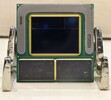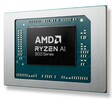Intel Core Ultra 5 238V vs AMD Ryzen AI 9 365
Intel Core Ultra 5 238V
► remove from comparison
The Intel Core Ultra 5 238V is a mid-range Lunar Lake family processor. This is an SoC for use in tablets and laptops of the slimmer kind that was unveiled in Autumn 2024. It features 4 new Skymont E-cores and 4 new Lion Cove P-cores running at up to 3.5 GHz and 4.7 GHz respectively, along with the new Arc 130V iGPU and 32 GB of on-package LPDDR5x-8533 RAM. A new 40 TOPS neural engine, Thunderbolt 4 and PCIe 5 SSD support are included as well. A vPro-enabled version of the CPU became available in early 2025.
The only difference between this chip and the Ultra 5 236V is the amount of on-package, non-replaceable RAM: 32 GB vs 16 GB respectively.
Architecture and Features
Lunar Lake is built using the Foveros technology (stacking several dies on top of each other and next to each other), just like Meteor Lake was. The new chips make use of the enormous BGA2833 socket interface. Of the 8 cores, not a single one is Hyper-Threading-enabled which is the opposite of what AMD currently does with its Zen 5/5c chips.
Intel claims Lion Cove cores bring a 14% IPC improvement over Redwood Cove. For Skymont and Crestmont, the difference is much higher at 68%. Several tweaks and improvements are present here, such as the Low Latency Fabric that is supposed to make small data transfers between cores/caches a lot faster. The 238V's level 3 cache is pretty small as compared to more expensive Ultra 7 2xxV and Ultra 9 2xxV chips at 8 MB vs 12 MB. Elsewhere, the 238V has 4 PCIe 5 and 4 PCIe 4 lanes for connecting various kinds of devices, including NVMe SSDs at up to 15.75 GB/s. Thunderbolt 4 support is onboard by default, as is support for CNVi WiFi 7 + BT 5.4 cards from Intel. The 40 TOPS "AI Boost" neural engine is present along with technologies such as Threat Detection to make AI-enabled applications such as the Windows Defender more powerful.
Intel is predicted to get short of on-package RAM in subsequent CPU generations.
Performance
Based on Geekbench 6.3 Multi test results available online in early Nov 2024, the 238V (and the 236V) delivers around 10,100 points, putting it on equal footing with chips such as AMD's Ryzen 7 7735HS and Apple's M2 which is an OK result for a thin-and-light laptop in late 2024.
Generally speaking, the 226V, 228V, 236V and 238V are slower than the 256V, 258V, 266V, 268V, 288V due to the difference in their last-level cache size (8 MB vs 12 MB) as well as clock speeds. However, the difference in performance between the slowest Lunar Lake chip, the 226V, and the fastest chip, the 288V is fairly small at around 10% to 15%. It depends on the TDP figures of the laptops being pitted against each other more than on anything else.
Graphics
The Arc Graphics 130V has 7 Xe² architecture "cores" running at up to 1,850 MHz, as well as 7 ray tracing units at its disposal. This is a direct successor to the Arc 7 iGPU; it is DirectX 12 Ultimate-enabled and able to HW-decode a long list of video codecs such as h.266 VVC, h.265 HEVC, h.264 AVC, AV1 and VP9. Three SUHD 4320p monitors can be used simultaneously with this iGPU.
Its performance can be vastly different depending on which benchmarks and games one runs. Oftentimes, it isn't much faster than its direct predecessor, the Arc 7. It is clear the 130V isn't fast enough to run most triple-A 2024 games at 1080p. However, it's still more than good enough for an occasional gaming session.
- Helldivers 2: 25 fps (Med, 1080p). The Arc 7 and the Radeon 880M deliver similar results.
- Ready or Not: 40 fps (Med, 1080p). The GeForce MX350 delivers a similar result.
Power consumption
This 2nd generation Core Ultra processor is supposed to consume 17 W when under long-term workloads. The Intel-recommended short-term power limit for the chip sits at 37 W.
AMD Ryzen AI 9 365
► remove from comparison
The Ryzen AI 9 365 is a relatively powerful Strix Point family processor that debuted in June 2024. The chip features 10 CPU cores running at 2.0 GHz to 5.0 GHz, along with the 12 CU RDNA 3.5 Radeon 880M graphics adapter and the 50 TOPS XDNA 2 neural engine. Other key features include PCIe 4, USB 4 and LPDDR5x-7500 RAM support.
Of the 10 CPU cores, 4 are full Zen 5 cores with the other 6 being smaller Zen 5c cores. The latter probably run at somewhat lower clock speeds than the former. In the meantime, the more expensive Ryzen AI 9 HX 370 has both more CPU cores and a faster 16 CU integrated graphics adapter.
Architecture and Features
Strix Point family APUs are powered by Zen 5 and Zen 5c microarchitecture cores found in two separate clusters, the latter being a slightly slower, smaller and more energy-efficient version of the former. One of the differences between Zen 5 and Zen 5c is cache size; Zen 5 cores have larger caches to work with.
Either way, mobile Zen 5 implementation is reportedly (ChipsAndCheese) closer to desktop Zen 4 than to desktop Zen 5 due to differing cache sizes, vast differences in AVX-512 throughput and other factors.
Elsewhere, the Ryzen AI 9 chip supports DDR5-5600 and LPDDR5x-7500 RAM, giving system designers a choice between lower latency and higher throughput respectively. The chip is natively compatible with USB 4 (and therefore Thunderbolt). It has PCIe 4.0 support for throughput of 1.9 GB/s per lane, just like its 8000 series predecessors did. The integrated XDNA 2 NPU, which is a lot more complex than first-gen XDNA was, delivers up to 50 INT8 TOPS for accelerating various AI workloads.
As is usual for laptop CPUs, the Ryzen is not user-replaceable as it gets soldered down for good.
Performance
At 30 W, this Ryzen AI 9 series CPU is only just fast enough to compete with much older chips such as the Ryzen 9 4900H and Ryzen 9 PRO 6950HS in multi-threaded benchmarks, suggesting power efficiency is the focus here rather than sheer performance.
Graphics
The Radeon 880M is the direct successor to the 780M. It packs just a few differences under the hood, such as faster caches; its 12 RDNA 3.5 architecture CUs/WGPs (768 unified shaders) run at up to 2,900 MHz. With well over 30 fps in both Once Human and The First Descendant (1080p - Low), this iGPU is certainly fast enough for a fair bit of casual as well as competitive gaming.
Naturally, the Radeon is capable of driving four SUHD 4320p60 monitors simultaneously. It can also efficiently encode and decode the most popular video codecs such as AVC, HEVC, VP9 and AV1. The latest addition to that list, the VVC codec, is not supported unlike it is with Intel Lunar Lake chips.
Power consumption
The 365 is supposed to have a base TDP of 28 W, with laptop makers free to crank it up to up to 54 W. Which they will most likely do to maximize performance.
The 4 nm TSMC process that these CPUs are built with makes for above average, as of late 2024, energy efficiency.
| Model | Intel Core Ultra 5 238V | AMD Ryzen AI 9 365 | ||||||||||||||||||||||||||||||||||||||||||||||||
| Codename | Lunar Lake | Strix Point (Zen 5) | ||||||||||||||||||||||||||||||||||||||||||||||||
| Series | Intel Lunar Lake | AMD Strix Halo/Point (Zen 5/5c, Ryzen AI 300) | ||||||||||||||||||||||||||||||||||||||||||||||||
| Series: Strix Halo/Point (Zen 5/5c, Ryzen AI 300) Strix Point (Zen 5) |
|
| ||||||||||||||||||||||||||||||||||||||||||||||||
| Clock | 2100 - 4700 MHz | 2000 - 5000 MHz | ||||||||||||||||||||||||||||||||||||||||||||||||
| L1 Cache | 1.4 MB | |||||||||||||||||||||||||||||||||||||||||||||||||
| L2 Cache | 14 MB | |||||||||||||||||||||||||||||||||||||||||||||||||
| L3 Cache | 8 MB | |||||||||||||||||||||||||||||||||||||||||||||||||
| Cores / Threads | 8 / 8 4 x 4.7 GHz Intel Lion Cove P-core 4 x 3.5 GHz Intel Skymont E-core | 10 / 20 4 x 5.0 GHz AMD Zen 5 6 x AMD Zen 5c | ||||||||||||||||||||||||||||||||||||||||||||||||
| TDP | 17 Watt | 54 Watt | ||||||||||||||||||||||||||||||||||||||||||||||||
| TDP Turbo PL2 | 37 Watt | |||||||||||||||||||||||||||||||||||||||||||||||||
| Technology | 3 nm | 4 nm | ||||||||||||||||||||||||||||||||||||||||||||||||
| max. Temp. | 100 °C | 100 °C | ||||||||||||||||||||||||||||||||||||||||||||||||
| Socket | BGA2833 | FP8 | ||||||||||||||||||||||||||||||||||||||||||||||||
| Features | LPDDR5x-8533 RAM, PCIe 5 + PCIe 4, USB 4, AI Boost NPU (40 TOPS), Thread Director, PSE, Threat Detection, MMX, SSE, SSE2, SSE3, SSSE3, SSE4.1, SSE4.2, AES, AVX, AVX2, AVX-VNNi, FMA3, SHA | DDR5-5600/LPDDR5x-7500 RAM, PCIe 4, USB 4, XDNA 2 NPU (50 TOPS), SMT, AES, AVX, AVX2, AVX512, FMA3, MMX (+), SHA, SSE, SSE2, SSE3, SSSE3, SSE4.1, SSE4.2, SSE4A | ||||||||||||||||||||||||||||||||||||||||||||||||
| iGPU | Intel Arc Graphics 130V ( - 1850 MHz) | AMD Radeon 880M ( - 2900 MHz) | ||||||||||||||||||||||||||||||||||||||||||||||||
| Architecture | x86 | x86 | ||||||||||||||||||||||||||||||||||||||||||||||||
| Announced | ||||||||||||||||||||||||||||||||||||||||||||||||||
| Manufacturer | ark.intel.com | www.amd.com |
Benchmarks
Average Benchmarks Intel Core Ultra 5 238V → 100% n=2
Average Benchmarks AMD Ryzen AI 9 365 → 121% n=2
* Smaller numbers mean a higher performance
1 This benchmark is not used for the average calculation













